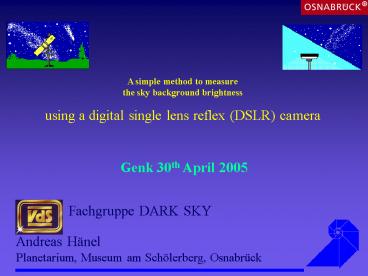Sky Background brightness - PowerPoint PPT Presentation
1 / 21
Title:
Sky Background brightness
Description:
using a digital single lens reflex (DSLR) camera. Andreas H nel ... DSLR camera Canon EOS 300D/digital rebel. CMos sensor: low noise, long exposure times ... – PowerPoint PPT presentation
Number of Views:115
Avg rating:3.0/5.0
Title: Sky Background brightness
1
A simple method to measure the sky background
brightness using a digital single lens reflex
(DSLR) camera
Genk 30th April 2005
Andreas Hänel Planetarium, Museum am
Schölerberg, Osnabrück
2
measuring light pollution brighter sky - less
stars how bright is the sky?
HannoverPierre Brunet
3
- measuring light pollution
- earlier work
- classical photometry, CCDs (eg. Berry Southern
Ontario) - Cinzano/Falchi (2000) conventional CCDs, Iris
- T. Seldon (2001) Coolpix 880, own program
- Jenik Hollan, Stuttgart 2003 own program, RAW
extract V - Wim Schmidt, Paris 2004 V-filter, AIP
- ...
- searched
- method without special camera, filter, special
program
4
DSLR camera Canon EOS 300D/digital rebel CMos
sensor low noise, long exposure times but lens
automatic distance -gt no infinity point
5
photo with Bayer pattern red - green - blue
6
Stellar magnitudesspectral response Johnson V
magnitude
Gehren
7
- RAW image --gt extract G image
- dcraw (Dave Coffin), C source
- deBayerizing filter (Photoshop)
- Astro-, camera software
Buil
8
- Determining instrumental magnitudes
- astronomical photometry
- daophot (MIDAS, IRAF ...)
- Astroart
- AIP4Win, Mira, MaxIm
- ...
- IRIS (Christian Buil)
- RAW -gt colour separation G frame
- subtract Dark
9
- simplifications
- no flat field (mainly vignetting) additional
noise! - stars near zenith (sec z lt 1.2) --gt no
extinction - no colour corrections
exposure time 10s (points!) 1600 ASA Tessar
f50mm/2,8
10
- methods for instrumental photometry
- peak intensity
- aperture photometry
- Point Spread Function fitting (eg. daophot)
11
aperture photometry (IRIS) starsmag - 2.5 log
I(inner circle)
"instrumental magnitudes"
12
Background brightness mag/arcsec² pixel size
-gt arcsec² Canon 300D 7.4µ x 7.4µ
13
calibration true lt-gt instrumental magnitude true
Johnson V magnitude magnitudes from eg. GUIDE
8 (Johnson V and Tycho/Hip VT ) accuracy
0.01m -gt Excel
14
calibration true lt-gt instrumental magnitude 1st
attempt linear correlation
-4.91
12.21
pixel size 12.2 7.42 19.6m
15
accuracy bright stars accurate, but extrapolation
16
calibration true lt-gt instrumental magnitude quite
large scatter 0,6 - 1,3 mag
2nd attempt difference obs-cat magnitude that
means slope 1 smaller scatter typical std.
deviation 0,2 mag
17
first results - accuracy garden 929
2005-01-06--1922 19,2 m/arcsec² 997
2005-01-16--0024 20,3 m/arcsec² 998
2005-01-16--0024 20,3 m/arcsec² 1220
2005-03-31--2303 19,7 m/arcsec²
observatory 991 2005-01-15--2342 20,8
m/arcsec² 1195 2005-03-31--2132 20,8
m/arcsec²
switch-off during night?
18
comparison with Cinzano (calibrated)
21.6
20.4
19.2
19
comparison with DMSP(uncalibrated)
20
- better results?
- digital lens with infinity point
- higher count rates background
- fast lens (11,4/30mm, available 05/05)
- longer exposure times (guiding?)
- multiple images (stacking)
- flat field, extinction?
- V-Filter (test colour corrections)?
- automated (faster) reduction
21
(No Transcript)































